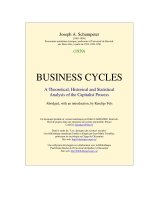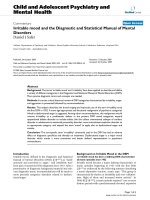Registration, atlas generation, and statistical analysis of high angular resolution diffusion imaging based on riemannian structure of orientation distribution functions 2
Bạn đang xem bản rút gọn của tài liệu. Xem và tải ngay bản đầy đủ của tài liệu tại đây (170.01 KB, 8 trang )
2
Background
2.1 Riemannian Manifold of ODFs
From existing literature [
41
,
45
,
48
], we know that at a specific spatial location,
x ∈ Ω
,
HARDI measurements can be used to reconstruct the ODF, the diffusion angular profile
of water molecules. The ODF is actually a diffusion probability density function (PDF)
defined on a unit sphere S
2
and its space is defined as
P = {p : S
2
→ R
+
|∀s ∈ S
2
, p(s) ≥ 0;
s∈S
2
p(s)ds =1} .
The space of
p
forms a Riemannian manifold, also known as the statistical manifold,
which is well-known from the field of information geometry [
82
]. Rao [
83
] introduced
the notion of the statistical manifold whose elements are probability density functions
and composed the Riemannian structure with the Fisher-Rao metric. Cencov [
84
]
showed that the Fisher-Rao metric is the unique intrinsic metric on the statistical
manifold
P
and therefore invariant to re-parameterizations of the functions. There
15
2. BACKGROUND
are many different parameterizations of PDFs that are equivalent but with different
forms of the Fisher-Rao metric, leading to the Riemannian operations with different
computational complexity. In this work, we choose the square-root representation,
which was used recently in ODF processing [
1
,
80
,
85
]. The square-root representation
is one of the most efficient representations found to date as the various Riemannian
operations, such as geodesics, exponential maps, and logarithm maps, are available in
closed form, as illustrated in Figure 2.1.
Figure 2.1:
Illustration of the manifold of square-root ODFs. (picture token and modified
from [1]))
The square-root ODF (
√
ODF
) is defined as
ψ(s)=
p(s)
, where
ψ(s)
is assumed
to be non-negative to ensure uniqueness. The space of such functions is defined as
Ψ = {ψ : S
2
→ R
+
|∀s ∈ S
2
, ψ(s) ≥ 0;
s∈S
2
ψ
2
(s)ds =1}. (2.1)
16
2.1 Riemannian Manifold of ODFs
We see that from Eq.
(2.1)
, the functions
ψ
lie on the positive orthant of a unit Hilbert
sphere, a well-studied Riemannian manifold. It can be shown [
86
] that the Fisher-Rao
metric is simply the L
2
metric, given as
ξ
j
, ξ
k
ψ
i
=
s∈S
2
ξ
j
(s)ξ
k
(s)ds, (2.2)
where
ξ
j
, ξ
k
∈ T
ψ
i
Ψ
are tangent vectors at
ψ
i
. The geodesic distance between any two
functions ψ
i
, ψ
j
∈ Ψ on a unit Hilbert sphere is the angle
dist(ψ
i
, ψ
j
)=log
ψ
i
(ψ
j
)
ψ
i
=cos
−1
ψ
i
, ψ
j
=cos
−1
s∈S
2
ψ
i
(s)ψ
j
(s)ds
,
(2.3)
where
·, ·
is the normal dot product between points in the sphere under the
L
2
metric.
For the sphere, the exponential map has the closed-form formula
exp(ψ
i
, ξ)=exp
ψ
i
(ξ) = cos(ξ
ψ
i
)ψ
i
+ sin(ξ
ψ
i
)
ξ
ξ
ψ
i
, (2.4)
where
ξ ∈ T
ψ
i
Ψ
is a tangent vector at
ψ
i
and
ξ
ψ
i
=
ξ, ξ
ψ
i
. By restricting
ξ
ψ
i
∈ [0,
π
2
]
, we ensure that the exponential map is bijective. The logarithm map
from ψ
i
to ψ
j
has the closed-form formula
−−−→
ψ
i
ψ
j
=log
ψ
i
(ψ
j
)=
ψ
j
−ψ
i
, ψ
j
ψ
i
1 −ψ
i
, ψ
j
2
cos
−1
ψ
i
, ψ
j
. (2.5)
17
2. BACKGROUND
2.2 Large Deformation Diffeomorphic Metric Mapping
2.2.1 Diffeomorphic Metric
In the setting of large deform diffeomorphic metric mapping (LDDMM), the set of
anatomical shapes are placed into a metric shape space. This is modeled by assuming
that the shapes are generated from one to the other via the group of diffeomorphisms,
G
. The diffeomorphisms are introduced as transformations of the coordinates on the
background space
Ω ⊂ R
3
, i.e.,
G :Ω→ Ω
. One approach, proposed by [
87
] and
adopted in this thesis, is to construct diffeomorphisms
φ
t
∈ G
as a flow generated
via ordinary differential equations (ODEs), where
φ
t
,t ∈ [0, 1]
obeys the following
equation (see Figure 2.2),
˙
φ
t
= v
t
(φ
t
),φ
0
= Id,t∈ [0, 1], (2.6)
where
Id
denotes the identity map and
v
t
are the associated velocity vector fields. The
vector fields
v
t
are constrained to be sufficiently smooth, so that Eq.
(2.6)
is integrable
and generates diffeomorphic transformations over finite time. The smoothness is
ensured by forcing
v
t
to lie in a smooth Hilbert space (
V
,
·
V
) with
s
-derivatives
having finite integral square and zero boundary [
88
,
89
]. In our case, we model
V
as
a reproducing kernel Hilbert space with a linear operator
L
associated with the norm
square
u
2
V
= Lu, u
2
, where
·, ·
2
denotes the
L
2
inner product. The group of
diffeomorphisms
G(V )
are the solutions of Eq.
(2.6)
with the vector fields satisfying
1
0
v
t
V
dt < ∞.
We define a metric distance between a target shape
I
targ
and a template shape
I
temp
as the minimal length of curves
φ
t
· I
temp
,t∈ [0, 1],
in a shape space such that, at time
18
2.2 Large Deformation Diffeomorphic Metric Mapping
Figure 2.2: Flow equation.
t =1
,
φ
1
· I
temp
is as similar as possible to
I
targ
. The latter notation represents the
group action of
φ
1
on
I
temp
. For instance, in the image case (see Figure 2.3), for which
I
temp
= I
temp
(x),x∈ Ω ⊂ R
3
,itis
φ
1
·I
temp
= I
temp
◦φ
−1
1
= I
temp
(φ
−1
1
(x))
. Lengths
of such curves are computed as the integrated norm
v
t
V
of the vector field generating
the transformation.
Figure 2.3:
Mapping one shape to another via the group action of diffeomorphic transfor-
mation. On the right, the diffeomorphisim φ is shown on the square grid.
Using the duality isometry in Hilbert spaces, one can equivalently express the
lengths in terms of m
t
, interpreted as momentum such that for each u ∈ V ,
m
t
,u◦ φ
t
2
= k
−1
V
v
t
,u
2
, (2.7)
where
k
V
is the reproducing kernel of
V
. We let
m, u
2
denote the
L
2
inner product
19
2. BACKGROUND
between
m
and
u
, but also, with a slight abuse, the result of the natural pairing between
m
and
v
in cases where
m
is a pointwise density. This identity is classically written as
φ
∗
t
m
t
= k
−1
V
v
t
, where
φ
∗
t
is referred to as the pullback operation on a vector measure,
m
t
. Using the identity
v
t
2
V
= k
−1
V
v
t
,v
t
2
= m
t
,k
V
m
t
2
and the standard fact that
energy-minimizing curves coincide with constant-speed length-minimizing curves, one
can obtain the metric distance between the template and target shapes,
ρ(I
temp
,I
targ
)
,
as
ρ(I
temp
,I
targ
)
2
= inf
m
t
1
0
<m
t
,v
t
◦ φ
t
>
2
dt (2.8)
The minimum being computed over all
m
t
such that
:
˙
φ
t
= v
t
(φ
t
)
,
v
t
= k
V
(φ
∗
t
m
t
)
,
φ
0
=id
and
φ
1
· I
temp
= I
targ
. Note that since in this thesis we are dealing with vector
fields in R
3
, k
V
(x, y) is a matrix kernel operator in order to get a proper definition.
2.2.2 Conservation Law of Momentum
One can prove that m
t
satisfies the following property at all times [90, 91].
Conservation Law of Momentum. For all u ∈ V ,
m
t
,u
2
= m
0
, (Dφ
t
)
−1
u(φ
t
)
2
. (2.9)
Eq.
(2.9)
uniquely specifies
m
t
as a linear form on
V
, given the initial momentum
m
0
and the evolving diffeomorphism
φ
t
. We see that by making a change of variables
and obtain the following expression relating
m
t
to the initial momentum
m
0
and the
geodesic φ
t
connecting I
temp
and I
targ
,
m
t
= |Dφ
−1
t
|(Dφ
−1
t
)
m
0
◦ φ
−1
t
. (2.10)
20
2.2 Large Deformation Diffeomorphic Metric Mapping
where
stands for the transpose of matrix.
As a direct consequence of this property, given the initial momentum
m
0
and the
initial diffeomorphism
φ
0
, one can generate a unique time-dependent diffeomorphic
transformation and consquently the evolving shape with time,
φ
t
· I
temp
, as shown in
Figure 2.4
Figure 2.4: Geodesic specified by initial momentum.
In the study of anatomical shapes and variation, pioneered by [
87
], we consider
the shapes as a manifold embedded in a high-dimensional space, where each shape is
considered as a point on the manifold. As a direct consequence of conservation law of
momentum, given the initial momentum
m
0
, one can generate a unique time-dependent
diffeomorphic transformation which connects one shape to another. Given a fixed
shape, referred to as atlas,
I
atlas
, the space of the initial momentum
m
0
, provides a linear
representation of the nonlinear diffeomorphic shape space in which linear statistical
analysis can be applied.
21
2. BACKGROUND
22









